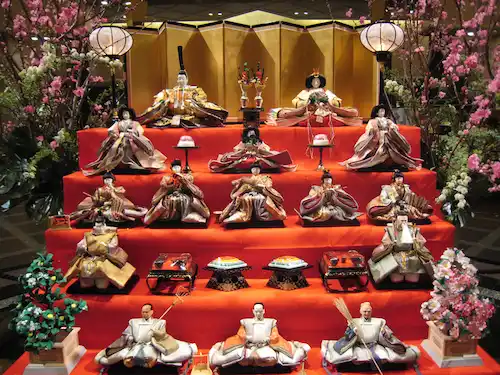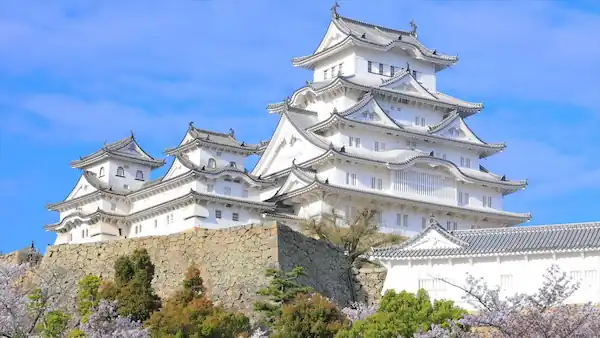The Enduring Charm of Hina Matsuri – A Bridge Connecting Centuries
Celebrated annually on March 3rd, Hina Matsuri, also known as “Momo no Sekku” (the Peach Blossom Festival), is a visually splendid and deeply symbolic Japanese tradition dedicated to wishing for the happiness and healthy growth of young girls.
The fact that this festival, with origins dating back over a thousand years, continues to thrive so vividly in contemporary Japan is a source of wonder and admiration.
It serves as a testament to the power of Japanese cultural continuity, a living bond connecting generations.
That rituals and emotions from a millennium ago still resonate today is proof of cultural dynamism – demonstrating that tradition is not a static relic but an actively evolving cultural practice.
This very dynamism may well be the secret to Hina Matsuri’s enduring appeal.
Table of Contents
- Other traditional events in Japan: How Does Ancient Japanese Elegance Influence Modern Culture Today?
This article will trace the rich history of Hina Matsuri, exploring the profound symbolism embedded in its central figures, the Hina dolls, particularly in their aspect as treasured family heirlooms.
Furthermore, we will illuminate the remarkable continuity of how this ancient tradition, while preserving its beautiful essence and adapting to the times, has been cherished, passed down, and has blossomed in modern Japan.
The universal and timeless human emotion of wishing for children’s happiness, transcending eras, forms the unwavering core of this festival, having sustained Hina Matsuri for centuries.
In this, we are reminded of the profound power of culture and the depth of human sentiment it embodies.
Whispers from the Past: Unraveling the Ancient Origins of Hina Matsuri
The origin of Hinamatsuri is like a complex tapestry woven from various cultural elements.
Tracing its roots reveals how ancient Japanese beliefs and play gradually merged over time.
One of the prototypes of Hinamatsuri was a purification ritual held on the first Day of the Snake in the third month of the old lunar calendar.
During this ritual, people would cleanse themselves by the water’s edge to ward off misfortune.
They transferred their impurities and misfortunes onto paper dolls called hitogata, and then floated them down the river, praying for health and protection.
This idea of entrusting a surrogate doll with one’s misfortunes and letting it drift away became a key element in the development of Hinamatsuri.
Japanese Soil: Ancient Purification Rites and Doll Play
Japan had its own ancient customs of purification.
There was a belief in transferring people’s impurities and misfortunes to “hitogata” (human-shaped effigies) or “katashiro” (substitutes) made of paper or grass, which were then cast into rivers or the sea to cleanse oneself.
This is considered the direct origin of “nagashi-bina” (floating Hina dolls), a practice still observed in some regions today, and one of the roots of Hina dolls.
During the Heian period (794-1185), a form of doll play called “hiina-asobi” (literally “small doll play,” akin to playing house) became popular among the daughters of court nobles.
Initially, simple paper dolls were used, but through this play, dolls transformed from mere ritual objects into objects of affection.
Fusion and Evolution: The Birth of Hina Matsuri
The ancient Japanese custom of purification using dolls and the “hiina-asobi” of Heian aristocrats gradually merged over a long period, forming the prototype of Hina Matsuri.
This syncretic nature of Hina Matsuri demonstrates the flexibility and receptiveness of Japanese culture.
By incorporating new elements onto an existing foundation of beliefs, it was able to take deeper root in Japanese society.
It is believed that the festival day was fixed as March 3rd around the Muromachi period (1336-1573).
The Edo period (1603-1868) was a landmark era during which Hina Matsuri developed significantly.
It was adopted as an imperial court event and was also actively celebrated in the Ooku (the women’s quarters of the Shogun’s castle).
More importantly, it was during this time that Hina Matsuri spread among the common people, and the practice of celebrating a girl’s first festival (hatsuzekku) by displaying Hina dolls – the form we recognize today – was born.
In this era, doll-making techniques also improved dramatically, leading to the creation of more elaborate and beautiful dolls.
As a result, dolls that were once set afloat transformed into cherished objects displayed with prayers for protection from harm.
This marked the moment when dolls, once purely ritualistic tools, were elevated to objects of affection and even potential family heirlooms, laying the groundwork for the tradition of passing Hina dolls down through generations.
It was also from this time that Hina Matsuri became strongly associated as a festival specifically for girls.
Waves of Modernization: Trials and Revival
Following the Meiji Restoration (1868 onwards), Hina Matsuri faced a temporary decline due to policies by the new government that abolished traditional seasonal festivals.
However, this beautiful tradition, deeply rooted in the lives of ordinary people, did not vanish from their hearts.
Thanks to its strong cultural foundation, Hina Matsuri eventually experienced a revival.
After World War II, with the improvement of the nation’s overall economic prosperity, Hina Matsuri spread even to regions that previously did not have the custom of displaying Hina dolls, and Hina dolls began to be mass-produced.
Socio-economic changes, such as the flourishing of merchant culture in the Edo period and post-war economic growth, spurred the popularization of Hina Matsuri.
This suggests that cultural practices are influenced not only by beliefs but also by people’s living standards and accessibility.
The widespread practice of Hina Matsuri we see today was made possible, in part, by this economic background.
| Era | Major Events |
|---|---|
| Ancient Japan | Purification using hitogata (human-shaped dolls) or katashiro; prototype of floating dolls (nagashi-bina) |
| Heian Period | Hina-asobi (doll play) among noble girls |
| Muromachi Period | Festival date became fixed on March 3 |
| Edo Period | Spread among common people; established as a festival for girls; custom of displaying hina dolls; advancement in doll-making techniques |
| Meiji Period | Temporary decline due to government policies, followed by revival |
| Post-WWII Period | Nationwide popularization; mass production of hina dolls |
Hina Dolls: Guardians of Wishes, Vessels of Inherited Love
Hina dolls are more than just beautiful decorations.
They embody the earnest wishes of parents for their children’s well-being and the family love passed down through generations.
The Profound Symbolism Embedded in Dolls
The most fundamental meaning of displaying Hina dolls is their role as “scapegoats” or substitutes. Since ancient times, dolls were believed to take on illnesses, disasters, and evil spirits that might afflict their owners.
Hina dolls are entrusted with the wish to protect girls from all misfortune and to help them grow into healthy, gentle women.
Parents and grandparents pray through Hina dolls for their daughters’ or granddaughters’ health, happiness, and traditionally, a good marriage.
In particular, the multi-tiered “dankazari” display is said to model a Heian period imperial court wedding, symbolizing the wish for the daughter to have a happy marriage and a prosperous life in the future.
A Glimpse into Artistry and Diversity
Hina dolls have evolved from simple paper “hitogata” to the diverse and elaborate forms seen today.
The main types include “ishougi-ningyo,” which are dressed in beautiful fabric costumes, and “kimekomi-ningyo,” where fabric is tucked into grooves carved into a wooden body to represent clothing.
Kimekomi dolls are relatively small and have a distinct, charming appearance.
There is also a rich variety of historical styles reflecting the aesthetic sense of each era, such as “Kyoho-bina” and “Kokin-bina,” and regional styles like “Goten-kazari,” which were once popular in the Kyoto-Osaka area and featured dolls displayed inside a miniature palace.
Taking the most luxurious “nanadan-kazari” (seven-tiered display) as an example, the dolls and their roles on each tier are as follows:
- Top Tier (1st Tier)
The Emperor (Obina) and Empress (Mebina), also known as Dairi-bina.- Their placement varies regionally.
Generally, in Kanto-style Hina (eastern Japan), the Emperor is on the viewer’s left, while in Kyo-Hina (Kyoto-style), he is on the viewer’s right.
This reflects the ancient court principle of “honoring the left side” (from the dolls’ perspective, the left being superior).
However, after Emperor Taisho’s enthronement ceremony, Western customs were adopted, and the modern Kanto-Hina style became widespread.
- Their placement varies regionally.
- Second Tier
Three Court Ladies (Sannin Kanjo), who serve sake (shirozake). - Third Tier
Five Musicians (Gonin Bayashi), a musical ensemble playing Noh or Gagaku court music to liven up the banquet. - Fourth Tier
Two Ministers (Zuishin), military officials who guard the Dairi-bina, often depicted as an old and a young man (traditionally Minister of the Right and Minister of the Left). - Fifth Tier
Three Servants or Protectors (Shichou or Jichou), who perform various tasks in the palace, characteristically depicted with crying, laughing, and angry expressions. - Sixth and Seventh Tiers
Exquisite miniatures of trousseau items are displayed, such as a small chest of drawers, a trousseau chest (nagamochi), a mirror stand, tea ceremony utensils, and an ox-drawn carriage.
The intricate detail of these items highlights the cultural importance and craftsmanship invested in this event and the wishes for the child.
| Tier | Dolls/Items | Symbolism/Role |
| 1st | Emperor (Obina) & Empress (Mebina) | Imperial marriage, ideal couple |
| 2nd | Three Court Ladies (Sannin Kanjo) | Court attendants, serving sake |
| 3rd | Five Musicians (Gonin Bayashi) | Orchestra, playing Noh/Gagaku music |
| 4th | Two Ministers (Zuishin – Minister of Right/Left) | Guardians, military officials |
| 5th | Three Servants (Shichou – often called “Sannin Jogo” – three drinkers) | Attendants with expressive faces, performing tasks |
| 6th/7th | Trousseau items (chest of drawers, mirror stand, carriage, etc.) | Preparations for marriage, wishes for a rich life |

Phto by wikipedia: https://ja.wikipedia.org/wiki/%E9%9B%9B%E7%A5%AD%E3%82%8A
The Core of Tradition: Hina Dolls Passed Down Through Generations
The custom of Hina dolls being passed down from mother to daughter, or grandmother to granddaughter, most movingly embodies the “inheritance of tradition” aspect of this festival.
These dolls become more than just material heirlooms; they are living testaments to the lineage of women in the family, their memories, love, and wishes spanning generations.
Each year they are displayed, the dolls reflect not only the current child but also the presence and wishes of past generations, making the dolls themselves storytellers of the family’s history.
However, this beautiful custom also has an interesting aspect.
Traditionally, Hina dolls are considered “scapegoats” that take on the misfortunes of one specific girl, so one set per girl was the basic principle.
This thinking leads to the concern that inheriting dolls might mean inheriting the previous owner’s misfortunes as well.
Nevertheless, out of a desire to cherish dolls filled with family history and love, Hina dolls are passed down in many families.
In such cases, a custom of purifying the dolls before giving them to the new owner is sometimes observed.
This demonstrates that tradition is not static but is actively reinterpreted and reshaped according to people’s emotions and practical needs – a “living tradition.”
Emotional connections can sometimes reshape traditional interpretations.
If there are sisters, it is ideally considered desirable to prepare Hina dolls for each of them.
This is to respect their role as “scapegoats” and also to ensure that each child feels equally cherished.
Even if the second doll set is a bit smaller, it is often prepared as an amulet for that child herself.
Modern Hina Matsuri: A Tradition Vibrantly Evolving
After more than a millennium, Hina Matsuri continues to be passed down without losing its brilliance, adapting to changes in modern Japanese lifestyles and values.
Its appearance is surprisingly lively, preserving good old traditions while incorporating new breaths of life.
Modern Celebrations: Joy Blooming in Homes and Communities
The way Hina Matsuri is celebrated in modern homes is a fusion of traditional elements and contemporary sensibilities.
- Decorating Hina Dolls
The centerpiece is, of course, the Hina doll display.
The custom of decorating from around Risshun (early February) to mid-February and putting them away promptly after March 3rd (to avoid the superstition that it might delay marriage) is still observed.
The sight of the whole family decorating together is a precious time for fostering intergenerational bonds. - Special Foods and Their Meanings
The Hina Matsuri dining table is adorned with vibrant, spring-like dishes, each with auspicious meanings:- Chirashizushi
A type of scattered sushi with auspicious ingredients like shrimp (longevity), lotus root (foresight), and beans (health, diligence), it’s also visually appealing. - Hina-arare
Colorful rice crackers – pink (warding off evil, health), green (life force, health), white (purity, fertility), and yellow (the four seasons).
Seasoning also varies by region (sweet in Kanto, savory in Kansai).
What is arare?: What is Okaki, Senbei, Arare?: Japanese Rice Crackers! - Hishimochi
Diamond-shaped rice cakes in three colors: red (pink for warding off evil), white (purity, fertility), and green (health, longevity).
Said to represent a spring scene. - Hamaguri no Osuimono (Clam Soup)
Clams, being bivalves, symbolize a harmonious marital union because only the original pair of shells fit perfectly together, representing a wish for a good marriage. - Shirozake / Amazake
Shirozake (sweet white sake) is for warding off evil spirits, while amazake (a non-alcoholic or low-alcohol sweet fermented rice drink, often for children) is nutritious and drunk with wishes for health.
The fact that these symbolic foods, even with modern twists, appear on the table is proof of their deeply rooted cultural significance.
- Chirashizushi
- Songs and Commemorative Photos
Singing the children’s song “Ureshii Hina Matsuri” (Happy Hina Matsuri) and taking commemorative photos of children in their best clothes with the Hina dolls are also enjoyable modern Hina Matsuri customs.
Adapting to the Times: The Background of Remarkable Continuity
Hina Matsuri remains so vibrant today because it has flexibly changed with the times.
- Compact and Modern Hina Dolls
Reflecting modern living environments (like apartments) and interior design, compact “Shinno-kazari” (displaying only the Emperor and Empress) and modernly designed Hina dolls are gaining popularity.
This can be seen as an effort to harmonize with modern life while preserving the essence of the tradition.
If tradition had rigidly adhered only to large, expensive sets, it might have become inaccessible to many and fallen into decline. - Community-wide Hina Matsuri Events
Many towns and cities across Japan host large-scale Hina Matsuri events displaying thousands of dolls, becoming major tourist attractions (e.g., “Big Hina Matsuri” in Katsuura, Chiba, and Katsuura, Tokushima; “Sagemon” in Yanagawa, Fukuoka).
This shows Hina Matsuri expanding from a private family celebration to a public festival enjoyed by the entire community.
This provides opportunities for families without young daughters or those who don’t own large displays to experience the tradition, broadening the culture’s reach.
It also gives a new role to Hina dolls that have fulfilled their primary purpose. - DIY and Personalization
There’s also a trend for families to enjoy their own original ways of celebrating, such as making handmade decorations or arranging dishes in a modern style. - Awareness of Sustainability
Initiatives conscious of sustainability are beginning to appear, such as Hina dolls made from environmentally friendly materials and eco-friendly events.
The Unwavering Essence: Unchanged Prayer
Despite these various changes and adaptations, the spirit at the core of Hina Matsuri has not wavered in the slightest.
It is the deep love of parents and family wishing for a girl’s healthy growth, happiness, and protection from misfortune.
And its important role in passing on this beautiful cultural heritage to the next generation and strengthening family ties continues to be fulfilled without change.
Hina dolls remain crucial cultural items for strengthening family bonds and experiencing the Japanese seasons.
Hina Matsuri – A Living Heritage Woven into Japanese Life
Looking back at the remarkable journey of Hina Matsuri, one cannot help but be astonished by the fact that it has consistently resonated deeply in people’s hearts, even as it transformed from ancient, simple purification rituals to the splendid, heartwarming festival of today.
Its incredible longevity is powerful proof that this tradition is deeply rooted in Japanese culture and people’s affections.
Particularly through the intergenerational inheritance of Hina dolls and related customs, Hina Matsuri plays the following crucial roles:
- Deepening Family Bonds
It connects intergenerational love, creates shared memories, and gives form to family wishes.
Celebrating Hina Matsuri can be seen as a “relay of happiness” that further deepens family ties.
In modern society, where family bonds are said to be weakening, such events where families gather are precious opportunities to reaffirm and nurture these ties. - Fostering Cultural Identity
It instills in children a pride and affection for their cultural heritage and fosters a sense of belonging. - Connecting with History
It provides a tangible means of encountering the values and lifestyles of past generations, promoting understanding and respect for history.
Hina Matsuri is not just a one-day event.
It is a continuous, beautiful thread woven from wishes, craftsmanship, and love, carefully preserved and lovingly passed on to the next generation.
In a rapidly changing and globalizing modern world, traditions like Hina Matsuri may also serve as cultural anchors, providing people with a sense of stability, identity, and connection to their roots.
The fact that this graceful and delicate tradition continues to thrive so powerfully is, in itself, a source of wonder and joy.
At its foundation lie universal and powerful human emotions: love for children, respect for ancestors, appreciation for beauty, and comfort in continuity.
These emotions are the driving force behind why people continue to invest time and effort in celebrating Hina Matsuri, promising its brilliant future.
Hina Matsuri is a shining example of how tradition can adapt to the times while preserving its core, and continue to thrive vibrantly.
And it will undoubtedly continue to be cherished in many homes, captivating and inspiring future generations.










Leave a Reply